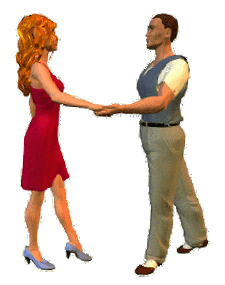Leading and Following in Open Positions
Exercise 2: Directional Movement

Stand facing your partner with a one-hand connection.
The elbows should be held low, slightly in front of and outward from the hips. The forearms should extend straight forward from the elbows, roughly parallel to the floor. Leader's palm should be turned upward; followers palm turned downward. The connection is sturdy but not heavy, without any squeezing or gripping of the partner's hand.
1. Push
Establish a push connection by shifting your weight towards each other to the point that you can feel each other's body weight working forward through the connection. Maintain this connection. Do not let it go, and do not switch to pull.
2. Move The Body
After you are fully satisfied that the connection is established, you can start to move. The leader should instigate the movement with a forward step. The follower will hopefully react with a step back.
To make matters simple, let's predetermine that the leader will take his first step forward with the left foot, while the follower will step back with the right. (This is not an absolute for all situations, but a good starting point for this exercise.)
Leaders: In order to be effective with your lead, you must fully shift your weight from one foot to another. After all, it's not the movement of your foot that the follower reacts to... it's the movement of your body weight.
3. Stop
After taking a total of 3 steps, stop moving, with the leader's weight forward on the left foot, and follower's weight back on the right. You can now release the push connection.
4. Pull
Establish a pull connection by shifting your weight away from each other to the point that you can feel each other's body weight working away from the connection. Maintain this connection. Do not let it go, and do not switch to push.
5. Move The Body
After you are fully satisfied that the connection is established, you can start to move. The leader should instigate the movement with a step back on the right foot. The follower will hopefully react with a step forward on the left.
6. Stop
After taking a total of 3 steps, stop moving, with the leader's weight back on the right foot, and follower's weight forward on the left. You can now release the pull connection and begin again.
Lather, Rinse, Repeat
And repeat. And repeat. This is an excellent exercise for connection training. The more you practice it, the better you'll get. As you get better, you can add difficulty to the exercise in the following ways:
-
Instead of predetermining that you will
take exactly 3 steps in each direction, allow the leader to determine how many (or few) steps to take. You can even shift the weight forward and back over one step, which is essentially a rock step. But remember, the connection must always be present before the movement can occur.
-
The leader can change the rhythm of the
steps, and the follower must use the weight connection to feel and react to the rhythm. You may use a predetermined rhythm, or if you're really good, you can improvise.
-
Add side steps to the mix. Side steps can be lead with either a push or a pull connection, so you don't even need to change the connection to lead the sideways movement. Try it!

